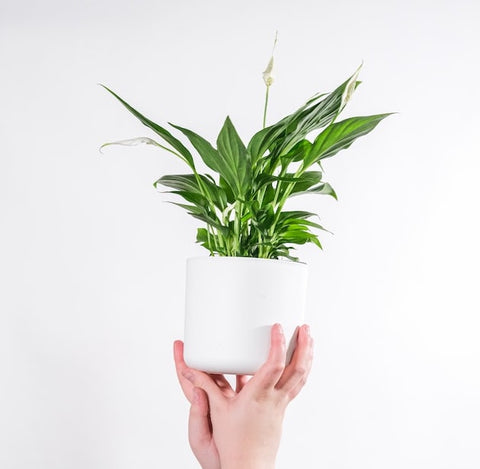Introduction
Have you ever heard of a Peace Lily? The Peace Lily is a popular indoor plant known for its elegant appearance and air-purifying qualities. It is native to tropical rainforests in South and Central America, and can grow up to 40cm tall. These lilies are known for their lush, green leaves and white flowers, which add a touch of elegance to any room.
Aside from its air-purifying benefits, the Peace Lily is also easy to care for. Peace Lilies are low maintenance and easy to care for, making them perfect for beginners or anyone who wants to add some greenery to their home without a lot of effort. Just give them some filtered light, water them once a week, and watch them thrive!

Light
Peace Lilies prefer moderate to low light conditions. Direct sunlight can scorch their leaves, so it's best to place them in a location that receives indirect or filtered light. However, too little light can also be detrimental to the plant's health and may cause it to stop producing flowers or grow more slowly.
If you're unsure about the light conditions in your home, you can monitor your Peace Lily's behavior to determine whether it's receiving enough light. If the plant's leaves are turning yellow or brown, it may be getting too much direct sunlight. On the other hand, if the leaves are drooping or the plant isn't producing flowers, it may need more light.
Overall, a bright, indirect light source is ideal for a healthy and thriving Peace Lily.
Water
Peace Lilies require regular watering to thrive, but it's important not to overwater them. Overwatering can lead to root rot and other problems, so it's important to find the right balance. A sustee soil moisture meter can help you achieve this.
A good rule of thumb is to water your Peace Lily once a week, allowing the soil to dry out slightly between waterings. The plant will tell you when it needs water by drooping slightly or wilting. This is a sign that it's time to water.
When watering your Peace Lily, be sure to water thoroughly, allowing the water to drain out of the bottom of the pot. Avoid letting the plant sit in standing water, as this can also lead to root rot.
In addition to regular watering, Peace Lilies benefit from occasional misting to increase humidity levels around the plant or by using a plant humidifier. This can help prevent the tips of the leaves from turning brown and keep the plant looking lush and healthy.
Soil
The right soil is crucial for the health and well-being of your Peace Lily. Here are some soil requirements for Peace Lilies:
- Moisture retention: Peace Lilies need soil that can hold moisture, but not become waterlogged. A good potting mix for Peace Lilies should be well-draining, while also retaining some moisture.
- Nutrient-rich: The soil should be nutrient-rich to provide the necessary nutrients for the plant's growth. You can add some organic matter like compost or aged manure to enrich the soil.
- Slightly acidic: Peace Lilies prefer slightly acidic soil with a pH of 5.5 to 6.5. You can test your soil pH with a soil test kit available at your local garden center.
- Loose and airy: The soil should be loose and airy to allow for proper air circulation and root growth. You can mix in some perlite or vermiculite to improve soil structure.
When repotting your Peace Lily, choose a container that is slightly larger than its current one and use fresh potting soil. It's best to repot in the spring or summer when the plant is actively growing. By providing the right soil for your Peace Lily, you can ensure its health and longevity.
How to fertilise peace lillies
Fertilising your Peace Lily is an important part of its care routine, as it provides the plant with essential nutrients to keep it healthy and thriving. Here are some tips on how to fertilise your Peace Lily:
- Choose the right fertiliser: Look for a balanced, water-soluble fertiliser with equal amounts of nitrogen, phosphorus, and potassium. You can find fertilisers specifically designed for Peace Lilies at your local nursery or garden center.
- Dilute the fertiliser: Mix the fertiliser with water according to the instructions on the label. Generally, you'll want to use about half the recommended strength to avoid over-fertilising your plant.
- Apply the fertiliser: Pour the diluted fertiliser onto the soil around the base of the plant, taking care not to get any on the leaves. You can fertilise your Peace Lily every 4-6 weeks during the growing season (spring and summer), and reduce or stop fertilising during the dormant season (fall and winter).
- Watch for signs of over-fertilisation: Too much fertiliser can burn the roots of your Peace Lily and cause damage to the plant. If you notice the tips of the leaves turning brown or the plant showing other signs of stress, reduce or stop fertilising for a while.
By following these steps, you can keep your Peace Lily healthy and thriving with regular fertilisation.
Are peace lillies pet safe?
Yes, peace lilies (Spathiphyllum spp.) are generally considered pet-safe plants. However, it's always a good idea to keep an eye on your pets and make sure they don't chew on or ingest any part of the plant. Additionally, it's important to note that while peace lilies are safe for pets, some other common household plants can be toxic, so always do your research before bringing any new plants into your home.
Propagation
Propagating Peace Lilies is a great way to expand your collection or share your plants with friends. Here are some simple steps to propagate your Peace Lily:
- Choose a healthy plant: Select a healthy Peace Lily that is at least a year old and has several stems and leaves.
- Remove the plant from its pot: Gently remove the plant from its pot and carefully separate the roots into two or more sections.
- Plant the new sections: Plant each new section in a pot filled with fresh potting soil. Water the plant thoroughly and place it in a bright, indirect light location.
- Wait for new growth: In a few weeks, new growth should emerge from the new sections.
Alternatively, you can propagate Peace Lilies through division by removing the plant from its pot, dividing it into smaller sections, and replanting each section in its own pot. Be sure to water the new sections thoroughly and keep them in a warm, humid location until new growth appears. You can also propagate using water and propagation stations.
By following these simple steps, you can propagate your Peace Lily and enjoy more of these beautiful plants in your home.
Peace lily drooping
If your peace lily (Spathiphyllum spp.) is drooping, it could be a sign of several different issues. Here are some common reasons why peace lilies droop and how to address them:
- Underwatering: Peace lilies like consistently moist soil, so if the soil is dry, the plant may start to droop. Water the plant thoroughly and make sure it's getting enough water on a regular basis.
- Overwatering: On the other hand, if the soil is too wet and waterlogged, the roots can become damaged and the plant may start to droop. Allow the soil to dry out slightly before watering again, and make sure the pot has good drainage.
- Low humidity: Peace lilies prefer humid conditions, so if the air is too dry, the leaves may start to droop. Increase the humidity around the plant by misting it regularly or placing a tray of water near the plant.
- Too much direct sunlight: Peace lilies prefer bright, indirect light, so if the plant is getting too much direct sunlight, the leaves may start to droop. Move the plant to a shadier spot.
- Root-bound: If the plant has outgrown its pot, the roots may be crowded and not getting enough nutrients. Repot the plant in a larger container with fresh soil.
By identifying and addressing the underlying issue, you can help your peace lily recover and thrive.
Peace lily yellow leaves
If your peace lily (Spathiphyllum spp.) has yellow leaves, it could be a sign of several different issues. Here are some common reasons why peace lily leaves turn yellow and how to address them:
- Overwatering: Overwatering is a common cause of yellowing leaves in peace lilies. Make sure you're not watering the plant too frequently, and that the soil has adequate drainage. Allow the soil to dry out slightly between waterings.
- Underwatering: On the other hand, if the soil is too dry, the leaves may also turn yellow. Water the plant thoroughly and make sure it's getting enough water on a regular basis.
- Low light: Peace lilies prefer bright, indirect light. If the plant is not getting enough light, the leaves may turn yellow. Move the plant to a brighter location, but avoid direct sunlight.
- Nutrient deficiency: If the plant is not getting enough nutrients, the leaves may start to yellow. fertilise the plant with a balanced fertiliser once a month during the growing season.
- Pest infestation: Some pests, such as spider mites and mealybugs, can cause yellowing leaves in peace lilies. Check the plant for signs of pests and treat with an insecticidal soap if necessary.
By identifying and addressing the underlying issue, you can help your peace lily recover and produce healthy green leaves.



